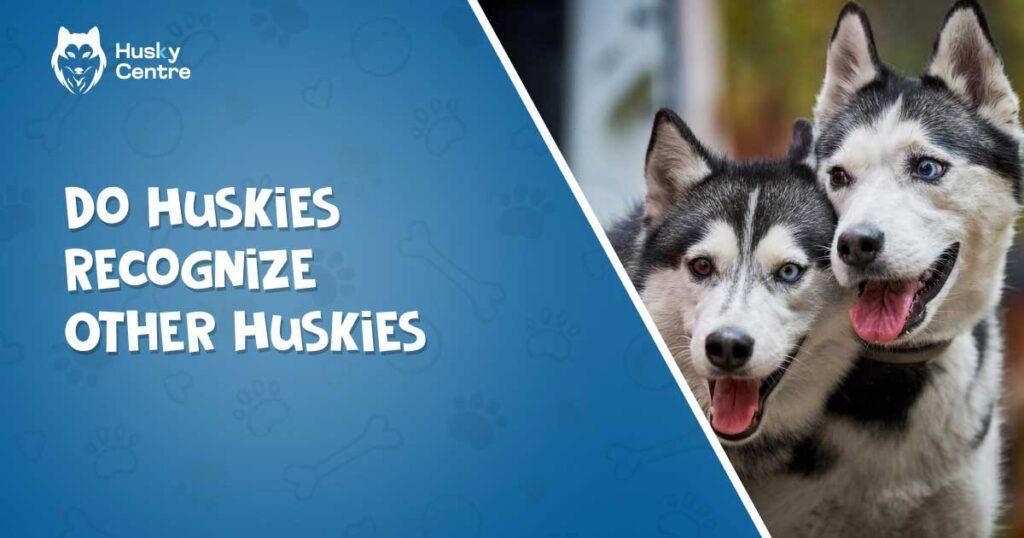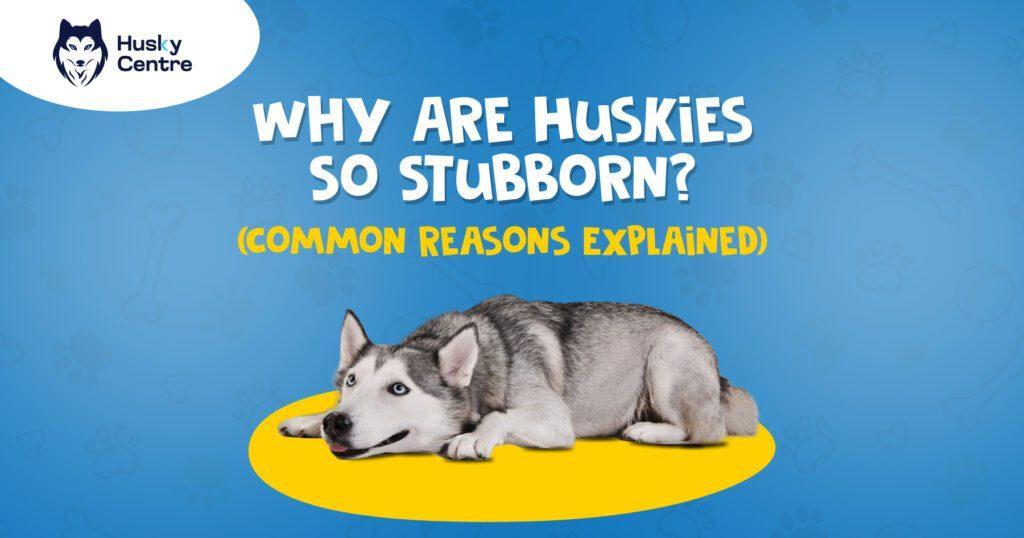Yes, Huskies can recognize other Huskies. They use visual and scent cues to identify their breed mates.
Huskies are known for their remarkable ability to recognize their own breed. This recognition stems from their keen sense of smell and acute visual perception. When encountering another Husky, they often display unique social behaviors, indicating a sense of familiarity and comfort.
This breed-specific recognition is vital for social bonding and pack dynamics. Huskies, with their distinct appearance and scent markers, can easily identify each other, even in a mixed group of dogs. Their natural inclination to form packs makes this recognition an essential trait, fostering better social interactions and cooperation among them. This fascinating ability highlights the complex social intelligence of Huskies.
Dog Breed Recognition
Do Huskies recognize other Huskies? It’s a question many dog owners ponder. Understanding dog breed recognition helps us learn about our pets’ interactions. Recognizing their own breed might influence their social behavior.
Can Dogs Recognize Their Own Breed?
Studies suggest dogs can recognize their own breed. Huskies, with their unique looks, might find it easier. Here are some ways dogs might recognize their breed:
- Appearance: Huskies have distinct features like blue eyes and thick fur.
- Behavior: Huskies share common behaviors such as howling and high energy.
- Play Style: Huskies enjoy rough play and might seek similar dogs.
Research shows dogs use visual and behavioral cues. They might feel more comfortable with similar-looking dogs. This could be because of:
| Feature | Husky Characteristics |
| Eyes | Bright blue or brown |
| Fur | Thick and double-coated |
| Size | Medium to large |
Being visually similar might help Huskies bond. They might recognize each other based on these traits.
How Dogs Use Scent And Sight For Identification
Dogs rely heavily on scent and sight. Huskies use these senses to identify others. Here’s how:
- Scent: Dogs have a powerful sense of smell. They can identify unique scents from other dogs. Each dog has a unique scent signature.
- Sight: Dogs also use sight to recognize familiar shapes and sizes. Huskies’ eyes and fur make them stand out.
Dogs sniff each other during greetings. This helps them gather information about age, gender, and health. Huskies might recognize other Huskies by matching scents with familiar smells.
Visual recognition plays a role too. Huskies might spot another Husky from afar. Their unique fur patterns and eye colors help. Dogs often combine these senses for accurate identification.
Combining scent and sight helps Huskies make friends. They feel safer around familiar smells and looks. This recognition forms the basis of their social interactions.
How Huskies Interact With Other Huskies
Huskies are known for their striking appearance and friendly demeanor. But do Huskies recognize other Huskies, and how do they interact with each other? Understanding their behavior can help owners foster better relationships among these beautiful dogs. Let’s explore how Huskies interact with other Huskies through their unique traits, mentality, and social behavior.
Unique Traits In Huskies
Huskies possess several unique traits that set them apart from other dog breeds. These traits not only influence their behavior but also their interactions with other Huskies. Here are some key characteristics:
- Playful Nature: Huskies are highly energetic and love to play. Their playful nature makes them great companions for other Huskies.
- Vocal Communication: Huskies are known for their vocalizations. They use howls, whines, and barks to communicate with each other.
- Pack Instinct: Huskies have a strong pack instinct. They enjoy being part of a group and often form close bonds with other dogs.
- Curiosity: Huskies are naturally curious. They love exploring and meeting new friends, including other Huskies.
These traits make Huskies social and interactive. Their playful and curious nature helps them form connections with other Huskies quickly.
Mentality And Social Behavior
Understanding a Husky’s mentality and social behavior is crucial for fostering positive interactions among them. Huskies are intelligent and have a high level of social awareness.
Intelligence: Huskies are very smart. They can quickly assess social situations and adapt their behavior accordingly.
Social Awareness: Huskies are keen observers. They pick up on social cues from other dogs and respond appropriately.
Hierarchy and Leadership: In a group, Huskies often establish a hierarchy. They recognize leadership and follow social structures within their pack.
Huskies are also known for their independent thinking. They can make decisions on their own, which sometimes leads to mischievous behavior.
Overall, Huskies thrive in social settings. Their intelligence and social awareness make them adept at interacting with other Huskies.
How Huskies Respond To Other Huskies
When Huskies meet other Huskies, their response is often positive and enthusiastic. They display a range of behaviors that indicate their interest and friendliness.
Greeting Rituals: Huskies have specific ways of greeting each other. They may sniff, circle, and use vocalizations to communicate.
Play Behavior: Play is a significant part of Husky interactions. They may chase, wrestle, and engage in games to bond with each other.
Body Language: Huskies use body language to express their feelings. Wagging tails, relaxed postures, and play bows are common signs of friendliness.
Below is a table that summarizes common Husky interactions:
| Behavior | Meaning |
| Sniffing | Getting to know each other |
| Howling | Communication |
| Play Bow | Invitation to play |
| Chasing | Play behavior |
These behaviors help Huskies form bonds and enjoy their time together. Their playful and social nature ensures they respond positively to other Huskies.
How Huskies Use Their Sense Of Smell To Identify Other Huskies
Do Huskies recognize other Huskies? This question fascinates many dog lovers. Huskies have unique ways to identify each other, and one of the most effective methods is through their sense of smell. Understanding how Huskies use their sense of smell to identify other Huskies can provide insights into their social behaviors and interactions.
Huskies have a highly developed sense of smell, which they use to recognize fellow Huskies. This sense is crucial for their social interactions and survival. Their ability to detect and differentiate scents is incredible.
Can Huskies Differentiate Scents?
Each Husky has a unique scent, much like human fingerprints. Huskies can distinguish between these scents with ease. They use this ability to identify family members, friends, and even strangers.
How Do Huskies Use Scent Marking?
Huskies often mark their territory with urine. This behavior helps them communicate with other Huskies. The scent markings contain information about the Husky’s age, gender, and health. Other Huskies can read these scent markers and understand who has been in the area.
The Role Of Pheromones
Pheromones play a significant role in Husky interactions. These chemical signals convey messages about readiness to mate, dominance, and territorial boundaries. Huskies have specialized receptors in their noses to detect these pheromones.
How Huskies Recognize Pack Members
Huskies are pack animals and have strong bonds with their pack members. They use their sense of smell to keep track of their pack. This ability helps them maintain social structure and ensures group cohesion.
Table: Differences In Scent Recognition Abilities
| Aspect | Huskies | Humans |
| Number of Scent Receptors | 220 million | 5 million |
| Scent Detection Range | Up to 40 miles | Limited to close range |
| Ability to Distinguish Scents | Extremely High | Moderate |
Understanding how Huskies use their sense of smell to identify other Huskies reveals their complex social structures and behaviors. Their noses are powerful tools, allowing them to navigate their world with precision and accuracy.
How Huskies Recognize Physical Traits In Other Huskies
Huskies are fascinating creatures with a keen sense of recognition. They possess a unique ability to identify other huskies based on distinct physical traits. Understanding how huskies recognize other huskies can shed light on their social behaviors and interactions. This section will delve into the key physical traits huskies use to recognize each other, focusing on size, coat, and eyes.
Size
Huskies often rely on size to identify other huskies. They are medium-sized dogs, typically weighing between 35 to 60 pounds and standing 20 to 23.5 inches tall. Recognizing another husky involves noticing these size parameters.
Here are some key points about husky size:
- Weight: Male huskies usually weigh more than females.
- Height: Male huskies are often taller than females.
- Build: Huskies have a muscular yet slender build.
When a husky encounters another dog, they observe these size characteristics. This helps them determine if the other dog is a fellow husky.
Consider this size comparison table:
| Gender | Weight | Height |
| Male | 45-60 pounds | 21-23.5 inches |
| Female | 35-50 pounds | 20-22 inches |
This comparison helps huskies recognize their own kind by size.
Coat
Another significant trait huskies use for recognition is their coat. Huskies have a double coat, which is thick and helps them withstand cold temperatures. The coat’s appearance and texture play a crucial role in identification.
Notable features of a husky’s coat include:
- Double Layer: An undercoat and a topcoat.
- Texture: Soft undercoat and a straight, smooth topcoat.
- Color Patterns: Common colors are black, white, gray, and red.
Huskies can recognize each other by these coat characteristics. They are adept at noticing the specific color patterns and textures of another husky’s fur.
Here’s a list of common coat colors and patterns:
- Black and White
- Gray and White
- Red and White
- All White
By observing these coat details, huskies can accurately identify other huskies in their vicinity.
Eyes
Huskies are famous for their striking eyes. Eye color and shape are vital traits for husky recognition. Huskies have almond-shaped eyes that come in various colors.
Key eye characteristics include:
- Eye Color: Blue, brown, or even bi-colored (one blue, one brown).
- Shape: Almond-shaped, giving them a keen and alert expression.
- Intensity: Bright and piercing look.
Huskies use these eye features to recognize each other. The unique eye colors and shapes make it easy for them to identify their kind.
Here’s a breakdown of eye colors:
| Color | Frequency |
| Blue | Common |
| Brown | Common |
| Bi-colored | Less Common |
By focusing on these eye details, huskies can easily recognize their fellow huskies.
Socialization And Familiarity
Huskies are known for their striking appearance and friendly nature. But do they recognize other Huskies? Socialization and familiarity play a big role in how these intelligent dogs interact with their own breed. Understanding their social behavior can help owners ensure a happy and well-adjusted pet.
Impact Of Early Socialization On Breed Recognition
Early socialization is crucial for Huskies. When they meet other dogs, especially other Huskies, they learn key social skills. These skills help them recognize and interact with their own breed later in life.
Huskies that socialize early tend to:
- Be more confident around other Huskies
- Develop better communication skills
- Show less aggression and more playfulness
Early socialization helps Huskies understand body language and vocal cues from other dogs. This familiarity makes it easier for them to recognize and bond with other Huskies.
| Benefits of Early Socialization | Impact on Breed Recognition |
| Increased Confidence | Better interaction with other Huskies |
| Improved Communication | Clear understanding of social cues |
| Reduced Aggression | More playful and friendly behavior |
Huskies that miss out on early socialization may struggle to interact with other Huskies. They might show signs of fear or aggression. This can lead to difficulties in recognizing and bonding with their breed.
Owners can ensure proper socialization by:
- Introducing their Husky to other dogs at a young age
- Setting up playdates with other Huskies
- Enrolling in puppy socialization classes
Regular interaction with other Huskies helps your pet become more familiar and comfortable. This early exposure is key to developing strong social bonds and breed recognition.
Do Huskies Prefer Interacting With Other Huskies?
Do Huskies recognize other Huskies? And do they prefer interacting with their own kind? These are common questions among Husky owners. Huskies are a unique breed with distinct characteristics. Understanding their social preferences can help ensure they lead a happy, healthy life.
Huskies are known for their high energy levels and playful nature. They often seek out other dogs with similar traits. This makes them naturally drawn to other Huskies. When two Huskies meet, they usually recognize each other through body language and vocalizations.
Huskies share a common language. This includes specific barks, howls, and physical cues. These shared behaviors can make interactions smoother and more enjoyable. They often engage in similar play styles, which can lead to stronger bonds.
Body Language And Vocalizations
Huskies use a range of body language signals to communicate. These include tail wagging, ear positioning, and facial expressions. They also have a unique way of howling and barking. These vocalizations are often understood better by other Huskies.
| Body Language | Description |
| Tail Wagging | Shows excitement and friendliness |
| Ear Positioning | Indicates attention and mood |
| Facial Expressions | Conveys emotions like happiness or curiosity |
Shared Play Styles
Huskies often engage in rough-and-tumble play. They enjoy chasing, wrestling, and mock fighting. These activities come naturally to them. When two Huskies play together, they usually understand each other’s limits and boundaries.
- Chasing games
- Wrestling matches
- Mock fights
Shared play styles can lead to stronger bonds. This can make Huskies prefer each other’s company over other breeds. Their similar energy levels also mean they can keep up with each other during playtime.
Pack Mentality
Huskies have a strong pack mentality. This means they thrive in groups and often seek out pack-like structures. When they recognize another Husky, they may see them as a potential pack member.
- Thrive in groups
- Seek pack-like structures
- Recognize potential pack members
Pack mentality can influence their social preferences. This can make them more inclined to form bonds with other Huskies. This instinctual behavior helps them feel more secure and content.
Do Huskies Show Preference For Their Own Kind?
Huskies are known for their striking appearance, intelligence, and friendly nature. Many owners wonder if these beautiful dogs can recognize and prefer their own breed. This curiosity leads us to explore the question: Do Huskies show preference for their own kind?
Do Huskies Have A Natural Affinity For Other Huskies?
Huskies often display a natural affinity for other Huskies. They tend to get excited when they see another dog that looks like them. This could be due to their pack mentality, which is strong in this breed. They may feel an instinctual connection to dogs that resemble them.
Visual Recognition In Huskies
Huskies rely on visual cues to recognize other Huskies. Their striking blue eyes and unique fur patterns make it easy for them to spot one another. When a Husky sees another dog with similar features, they often become more curious and friendly. This visual recognition helps them identify their own kind quickly.
Behavioral Responses To Fellow Huskies
Huskies often exhibit specific behaviors when they encounter another Husky. These behaviors include wagging their tails, barking excitedly, and engaging in playful actions. They may also show a higher level of comfort and confidence around their own kind. This behavior suggests a preference for interacting with other Huskies.
Social Bonding Among Huskies
Huskies are social animals and love to form bonds. They tend to bond faster with other Huskies due to their shared traits and behaviors. This bonding can lead to deeper and more meaningful interactions. They often enjoy playing, running, and even howling together. This strong social connection enhances their preference for fellow Huskies.
Studies And Observations
Several studies have shown that Huskies often show a preference for their own breed. Observations in dog parks and social settings confirm this behavior. Huskies often gravitate towards each other, forming small groups within larger dog communities. This preference is noticeable and consistent across different environments.
Factors Influencing Preference
| Factor | Explanation |
| Visual Similarity | Huskies recognize and are drawn to dogs that look like them. |
| Pack Mentality | They have a strong instinct to bond with similar-looking dogs. |
| Social Behavior | They show more playful and friendly behavior towards other Huskies. |
Frequently Asked Questions
Do Huskies Recognize Their Siblings?
Yes, Huskies can recognize their siblings. They rely on scent and visual cues. This helps them identify family members.
Can Huskies Identify Other Huskies?
Yes, Huskies can identify other Huskies. They use scent, appearance, and behavior. This allows them to recognize their own breed.
How Do Huskies Recognize Each Other?
Huskies recognize each other through scent and visual cues. They also use body language and vocalizations.
Do Huskies Prefer Other Huskies?
Huskies often prefer the company of other Huskies. They share similar energy levels and communication styles. This makes them good companions.
Conclusion
Huskies have an incredible ability to recognize their own breed. This recognition stems from their unique social skills. Understanding this can help in fostering better social interactions. By acknowledging their traits, we can ensure happier and healthier Huskies. Embrace their natural instincts for a harmonious relationship.


Meet Jarred, the heart and soul behind HukyCentre. With a deep affection for furry friends, he pours his passion into every word he writes. His genuine love for dogs shines through in his engaging and informative content. As a dedicated dog enthusiast, Jarred’s goal is to share valuable insights and tips that resonate with fellow dog lovers. Join Jarred on the journey as he celebrates the joy and companionship that dogs bring into our lives.



